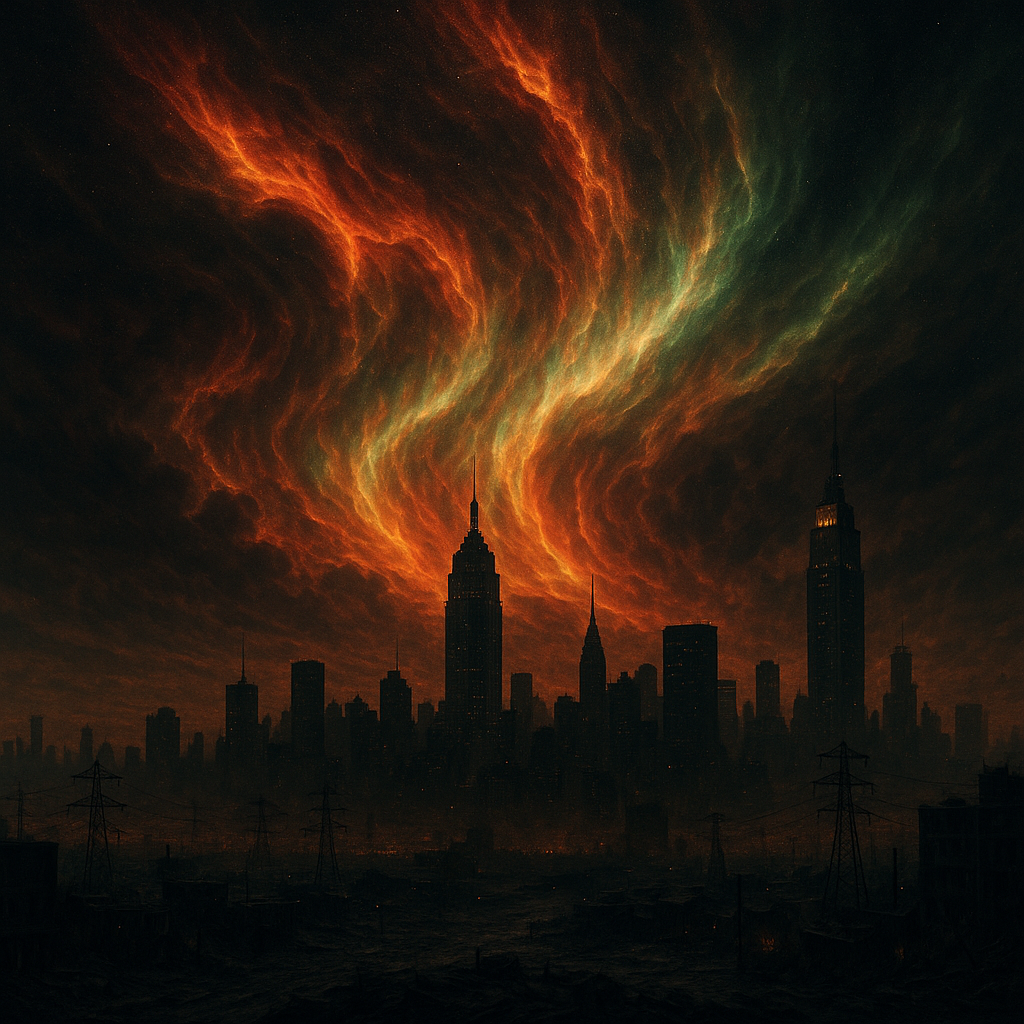Carrington 2026

When the Sun Strikes Back
In September 1859, the sun struck the Earth harder than at any other time in recorded history.
A massive solar storm, known as a coronal mass ejection, erupted from the sun and hit Earth’s magnetic field.
The first man to witness it was an English astronomer named Richard Carrington. He was sketching sunspots when a blinding flash of white light burst from the solar surface. Minutes later, the telegraph network across Europe and North America began to fail.
Telegraph operators reported sparks leaping from their machines. Some were knocked unconscious. Fires started on desks as paper ignited. Telegraph lines kept transmitting even after being unplugged because the storm itself was charging the wires.
In the night sky, auroras glowed as far south as Cuba and Hawaii. People could read newspapers at midnight by the eerie red and green light.
The event lasted for two days. Then it ended as suddenly as it began.
They called it the Carrington event of 1859. A one-time thing.
Why It Happened
A coronal mass ejection is a vast cloud of charged particles thrown from the sun during a flare. When that cloud reaches Earth, it slams into the planet’s magnetic field and drives electric currents through the atmosphere and the ground.
In 1859, those currents overloaded telegraph wires. Today, they would overload everything.
Modern civilization runs on delicate electronics. Power grids, satellites, airplanes, hospitals, water systems, and financial markets all depend on them.
A Carrington-level storm now would burn out high-voltage transformers, fry satellites, and erase data on a global scale. It would erase our civilization.
Transformers take months or even years to replace. Without them, the grid would stay dark. Air travel would halt. Supply chains would freeze. Emergency services would fail. Within days, grocery shelves would empty. Within weeks, cities would become unlivable. Looting, tribalism, and the worst in humanity would be on full display.
Why People Thought It Could Never Happen Again
After 1859, the world moved on. Electricity was still new. Most people didn’t understand what had happened, and there was no real reason to worry.
When smaller solar storms hit later, they caused minor issues and then faded from memory.
As technology advanced, we built networks that depended completely on constant electricity and clean data signals. We wrapped the planet in satellites and fiber optics, but we never built serious protection against another Carrington-level storm. Engineers and governments assumed it was a one-time fluke. The odds seemed tiny.
Quebec was even taken dark for 9 hours due to a CME back in 1989.
In 2012, NASA detected another massive solar storm that missed Earth by just a few days of orbital alignment. If it had hit, we would have learned the hard way that 1859 was not a freak accident.
Most of our satellites are still unshielded. Most of our power grids are still vulnerable. We keep telling ourselves that it will not happen again.
We say that because it is easier than admitting how fragile we really are.
If It Happened Now
Hour 0: The Flare
NASA’s satellites spot a massive eruption on the sun. It looks like an ordinary solar flare until instruments pick up the scale. A coronal mass ejection has been launched directly toward Earth. We have about 14 to 18 hours before impact.
A few government agencies quietly prepare. Most people do not hear about it. The story barely makes the news.
Hour 6: The Calm Before
Airlines receive early warnings to be ready for satellite disruptions. Power grid operators talk about shifting voltage loads. But no one really believes the worst-case scenario will happen.
Social media argues about whether it is overblown. Reddit melts down. Life goes on.
Hour 14: The Arrival
The leading edge of the plasma cloud slams into Earth’s magnetic field. Northern skies explode into color. Auroras appear over Canada, then the Midwest, then the southern states. People come outside to film it on their phones and show their followers.
Within minutes, cell service drops to zero. The magnetic pulse knocks out satellites and fries power relays. GPS signals vanish.
Hour 15: Lights Out
Electrical grids begin to collapse, one region at a time.
High-voltage transformers overheat and burn out. They cannot be repaired in place. The East Coast goes first, followed by the Midwest. Then Europe and Asia.
Cities like New York, Chicago, London, and Tokyo go dark within thirty minutes of each other. Entire regions lose both power and communication. Backup generators fail because their circuitry is cooked. Hospitals lose life support systems. Elevators stop between floors. Subways fill with smoke as trains grind to a halt.
Hour 18: Global Blackout
Within eighteen hours of the flare hitting, nearly all major power grids on Earth are down. Anything with a circuit board is dead. Airplanes lose navigation and control. Air traffic control towers cannot communicate. Some planes attempt emergency landings. Others simply vanish from radar.
Banking systems fail instantly. Credit and debit cards no longer work.
Water treatment plants stop pumping. Fuel stations stop running.
Governments attempt to reach each other through backup radios, but the electromagnetic storm fills the atmosphere with static. The sky itself becomes a wall of noise.
The First Night
By the time darkness falls, more than half of humanity is without power.
The big cities, once glowing like constellations, are black voids seen from space.
In New York, people crowd into the streets thinking it is temporary. Looting starts. The people panic. In Los Angeles, traffic jams stretch for miles. Looting and lawlessness starts nearly immediately there, as well as in Chicago. People walk home along the interstate, the skyline behind them a dead shadow.
No one realizes that the transformers that powered their world are already ruined beyond repair.
By morning, every major city on Earth is silent. No phones. No internet. No running water.
The First Week
Generators at hospitals and data centers burn through fuel within days. Food spoils. Refrigerated medicine is gone.
The average city has less than three days of food stored at any time. Without power or transport, that supply vanishes almost immediately.
The first week brings panic, then more violence. Police radios are dead. Fire departments run out of water pressure.
Within ten days, most urban areas are uninhabitable.
The Real Timeline
NASA and the National Academy of Sciences estimate that restoring a modern electrical grid after a Carrington-level event could take months to years.
Transformers weigh hundreds of tons and are custom built. Many are manufactured overseas. Without power or communication, replacement and shipping would be impossible.
The cities would not wait for the lights to come back on.
They would empty.
How Soon the Big Cities Would Go Black
Within fifteen hours of impact, the grid would unravel worldwide.
And within one week, the cities themselves would fall silent.
Not because the power was out.
Because the people were gone.
And like that, civilization and all its trivialities were gone forever.
Written by Matt Stone
The Grounded guarantees factual accountability. If a paid subscriber identifies a verified factual error in our reporting, we will pay them $100.
Works Cited
Carrington, Richard C. Description of a Singular Appearance Seen in the Sun on September 1, 1859. Monthly Notices of the Royal Astronomical Society, vol. 20, 1860, pp. 13–15.
National Aeronautics and Space Administration (NASA). “Near Miss: The Solar Superstorm of July 2012.” Science@NASA, 23 July 2014, https://science.nasa.gov/science-research/planetary-science/23jul_superstorm/.
National Academy of Sciences. Severe Space Weather Events—Understanding Societal and Economic Impacts: A Workshop Report. The National Academies Press, 2008. https://nap.nationalacademies.org/read/12643.
Love, Jeffrey J., et al. “Probabilistic Estimates of Extreme Geomagnetic Storm Intensity.” Space Weather, vol. 13, no. 9, 2015, pp. 611–622. DOI:10.1002/2015SW001232.
Riley, Pete. “On the Probability of Occurrence of Extreme Space Weather Events.” Space Weather, vol. 10, no. 2, 2012. DOI:10.1029/2011SW000734.
International Telecommunication Union (ITU). “Solar Storms: Are We Ready for Another Carrington Event?” ITU Newsroom, Aug. 2024, https://www.itu.int/hub/2024/08/solar-storms-are-we-ready-for-another-carrington-event-2/.
KQED Science. “How Solar Storms That Bring Northern Lights Can Also Cause Tech Chaos.” KQED, 3 May 2023, https://www.kqed.org/science/1992826/how-solar-storms-that-bring-northern-lights-can-also-cause-tech-chaos.
Odenwald, Sten F., and James L. Green. “Bracing for a Solar Superstorm.” Scientific American, vol. 297, no. 2, Aug. 2007, pp. 80–87. DOI:10.1038/scientificamerican0807-80.


Comments ()